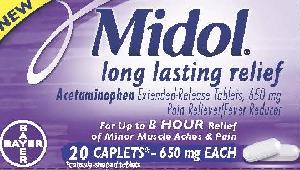Midol Long Lasting Relief Interactions
There are 160 drugs known to interact with Midol Long Lasting Relief (acetaminophen), along with 3 disease interactions, and 2 alcohol/food interactions. Of the total drug interactions, 8 are major, 116 are moderate, and 36 are minor.
- View all 160 medications that may interact with Midol Long Lasting Relief
- View Midol Long Lasting Relief alcohol/food interactions (2)
- View Midol Long Lasting Relief disease interactions (3)
Most frequently checked interactions
View interaction reports for Midol Long Lasting Relief (acetaminophen) and the medicines listed below.
- Abilify (aripiprazole)
- Adderall (amphetamine / dextroamphetamine)
- Adipex-P (phentermine)
- Advil (ibuprofen)
- Allegra (fexofenadine)
- amitriptyline
- amoxicillin / clavulanate
- amphetamine / dextroamphetamine
- Aspercreme Maximum Strength Lidocaine Patch (lidocaine topical)
- atorvastatin
- Aurovela Fe 1.5 / 30 (ethinyl estradiol / norethindrone)
- azathioprine
- Azo Urinary Pain Relief (phenazopyridine)
- B-Complex SR (multivitamin)
- Benadryl (diphenhydramine)
- Claritin (loratadine)
- ibuprofen
- Iron Sulfate (ferrous sulfate)
- lamotrigine
- levothyroxine
- magnesium glycinate
- Motrin (ibuprofen)
- Mucinex (guaifenesin)
- naproxen
- pantoprazole
- prednisone
- propranolol
- sertraline
- spironolactone
- Vitamin D3 (cholecalciferol)
Midol Long Lasting Relief alcohol/food interactions
There are 2 alcohol/food interactions with Midol Long Lasting Relief (acetaminophen).
Midol Long Lasting Relief disease interactions
There are 3 disease interactions with Midol Long Lasting Relief (acetaminophen) which include:
More about Midol Long Lasting Relief (acetaminophen)
- Compare alternatives
- Drug images
- Latest FDA alerts (16)
- Side effects
- Dosage information
- During pregnancy
- Drug class: miscellaneous analgesics
- Breastfeeding
Related treatment guides
Drug Interaction Classification
| Highly clinically significant. Avoid combinations; the risk of the interaction outweighs the benefit. | |
| Moderately clinically significant. Usually avoid combinations; use it only under special circumstances. | |
| Minimally clinically significant. Minimize risk; assess risk and consider an alternative drug, take steps to circumvent the interaction risk and/or institute a monitoring plan. | |
| No interaction information available. |
See also:
Further information
Always consult your healthcare provider to ensure the information displayed on this page applies to your personal circumstances.


